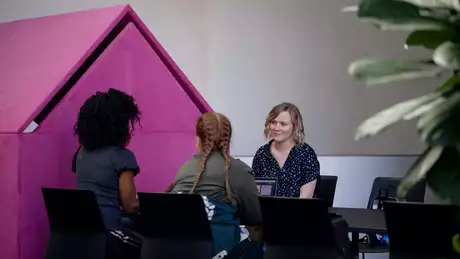
The need for master's education in rehabilitation in Tanzania and Kenya—the AfroRehab partnership
Published: 12.05.2025 / Blog / Publication
Higher Education Institutions (HEIs) hold a responsibility in contributing to global development. Introducing a master's-level education in rehabilitation is essential to build local expertise, improve quality of rehabilitation, and support health system development in Kenya and Tanzania.
There is a growing demand for advanced rehabilitation services in Tanzania and Kenya, driven by an increase in non-communicable diseases (NCDs), road traffic accidents, aging populations, and disability-related needs. According to the World Health Organization, over 15% of the global population lives with some form of disability, and this number is steadily rising—particularly in low- and middle-income countries. In Kenya, approximately 13 % of adults aged 15 and older experience functional difficulties, with visual, mobility, and cognitive impairments being most common. Tanzania faces a similar burden, with limited national data, but regional studies indicating high levels of unmet rehabilitation needs. Additionally, the healthcare workforce remains severely under-resourced. For example, Tanzania has a shortage of rehabilitation professionals and only 1 doctor per 25,000 people and 1 nurse per 23,000 people, far below WHO recommendations. In Kenya, the health workforce is around 24% below the required level, with a projected shortfall of over 200,000 health workers by 2035 if no intervention is made. (WHO 2022).
Despite these challenges, there are very few opportunities for advanced rehabilitation training in both countries. Master's-level education is essential to fill this critical skills gap. It would enable the development of clinical leaders, educators, and researchers who can strengthen service delivery, influence policy, and build sustainable, locally-driven rehabilitation systems. Investment in postgraduate education is not only an academic imperative but a public health priority to ensure equitable access to high-quality rehabilitation services.
As key agents of knowledge production, innovation, and human capital development, HEIs are expected to address global disparities by promoting inclusive education, sustainable development, and social justice. This responsibility extends beyond national borders, involving the creation of equitable international partnerships, the strengthening of institutional capacities, and the support of research initiatives that are locally relevant and globally informed. HEIs can play a transformative role in empowering communities, reducing inequality, and fostering long-term development in areas as the Global South. In the AFROREHAB project four African Universities, two in Tanzania and two in Kenya, and two European Universities from Norway and Finland will collaborate in developing and implementing a blended Master of Science (MSc) degree in Rehabilitation, one in each African country1. The aim for the AfroRehab partnership is to strengthen the rehabilitation workforce in East Africa by developing an innovative educational digital ecosystem with interdisciplinary master programmes in rehabilitation. These master programmes will secure sustainable training of qualified physiotherapists, occupational therapists, prosthetists and orthotists, speech and language therapists, audiologists and optometrists in Tanzania (TZ), Kenya (KE) and beyond. It will promote rehabilitation services and research across sectors.
Global challenges for the development of competence in the field of rehabilitation
The development of competence in the field of rehabilitation faces several global challenges that hinder the provision of high-quality, equitable care. One of the most pressing issues is the unequal access to education and specialized training, particularly in low- and middle-income countries (WHO, 2017). This disparity contributes to a critical shortage of qualified rehabilitation professionals.
Rehabilitation professionals develop their skills and carry out their work within broader systems and environments that play a critical role in shaping their effectiveness and the outcomes of their interventions. The full potential of the rehabilitation workforce to improve population functioning can only be achieved when key factors—such as governance, funding, assistive technologies, information systems, and service delivery—are addressed together. The Rehabilitation Competency Framework (RCF, WHO 2020) serves as a valuable tool in this context, supporting competency-based approaches to education, training, regulation, workforce planning, and human resource management. Through its application, the RCF helps ensure that the rehabilitation workforce is equipped to meet population needs and deliver high-quality, person-centred care. (Mills et al 2021)
The rapid expansion of digital health and tele-rehabilitation has introduced new opportunities, but also challenges, as not all professionals have access to digital tools or the training required to use them effectively, highlighting a growing digital divide (Zampolini & Todeschini, 2021). Cultural and contextual barriers also play a significant role, as differing societal views on disability and varying health system infrastructures influence how competence is understood and applied in practice (Mannan & Turnbull, 2007). In addition, continuing professional development opportunities are often limited, especially in resource-constrained settings, impeding practitioners’ ability to keep up with evidence-based practices (Middleton et al., 2022). Finally, the global rehabilitation workforce is further strained by the migration of skilled professionals from developing regions to high-income countries, a phenomenon that deepens existing inequalities and leaves vulnerable populations underserved (Buchan & Aiken, 2008). Addressing these multifaceted challenges requires coordinated international efforts focused on policy reform, educational access, and sustainable workforce development.
Stakeholder based need analysis for developing rehabilitation competencies in Tanzania and Kenia
To ensure that graduates from the programme possess the competencies needed for capacity building in the field, it is necessary that, before developing a curriculum, views from the stakeholders should be collected to identify the essential requirements and gaps for the intended programme. This process is especially critical in addressing cultural and contextual challenges, as the expectations and roles of rehabilitation professionals can vary significantly between countries and even regions. Cultural perceptions of disability, societal roles of healthcare professionals, the structure of local health systems, and available resources all influence essential knowledge and skill.
To fulfil this, a questionnaire was sent to gather information from rehabilitation professionals, employers, and the community about the need for educated rehabilitation professionals in the two countries. This approach ensured that diverse, context-specific needs were captured, rather than imposing a one-size-fits-all curriculum model. The focus was on highlighting the issues that can impact how the curriculum is developed to respond not only to technical competencies, but also to the sociocultural realities and expectations of the communities served. Understanding these cultural and contextual nuances is vital for developing a relevant, sustainable, and impactful master’s programme. As a result, 507 responses were gathered for the three surveys covering the two countries.
The responses revealed key themes for programme design, with “digital competence” emerging across all groups—highlighting the need for digital skills, tool integration, and support for lifelong learning. “Advancement of clinical competence” was also emphasized, focusing on evidence-based practice, innovation, and interprofessional collaboration. Community feedback stressed inclusion and accessibility, while employers prioritized communication, leadership, and ethics. A blended learning approach—combining onsite and online teaching—was the preferred delivery method.
Conclusions
In conclusion, the curriculum should support students in building the competencies needed to effectively use digital tools, apply evidence-based practices, and engage in innovation within interprofessional settings. It should also promote inclusion, enhance access to rehabilitation, and ensure safe, expert practice within their respective disciplines. A challenge with the new master's programme is to enable both in-depth clinical knowledge within a specific profession as well as common understanding of central concepts and frames of reference to develop competence for interprofessional collaboration in clinical patient work.
1 The AfroRehab2030 project, funded by the European Union (EU), launched on October 1, 2024, will run for three years. The participating universities include Jomo Kenyatta University of Agriculture and Technology (JKUAT), Moi University, Kilimanjaro Christian Medical University College (KCMUCo), and Muhimbili University of Health and Allied Sciences (MUHAS) from Africa, along with Western Norway University of Applied Sciences (HVL) and Arcada University from Europe. https://afrorehab-eu.org/
Annikki Arola
Ira Jeglinsky-Kankainen
Camilla Wikström-Grotell
References
Buchan, J., & Aiken, L. (2008). Solving nursing shortages: a common priority. Journal of Clinical Nursing, 17(24), 3262–3268.
Mannan, H., & Turnbull, A. P. (2007). Globalization and disability: A review of literature. Disability & Society, 22(5), 443–456.
Middleton, J. W., et al. (2022). Continuing education and lifelong learning in rehabilitation: Challenges and opportunities. Journal of Rehabilitation Medicine, 54, jrm00216.
Mills, J. A., Cieza, A., Short, S. D., & Middleton, J. W. (2021). Development and Validation of the WHO Rehabilitation Competency Framework: A Mixed Methods Study. Archives of physical medicine and rehabilitation, 102(6), 1113–1123. https://doi.org/10.1016/j.apmr.2020.10…
Zampolini, M., & Todeschini, E. (2021). Tele-rehabilitation: present and future. European Journal of Physical and Rehabilitation Medicine, 57(2), 192–200.
WHO World Health Organization (2017). Rehabilitation 2030: A Call for Action. WHO.
https://www.who.int/publications/i/item…
World Health Organization. (2020). Rehabilitation Competency Framework. WHO
ISBN 978-92-4-000828-1 (electronic version). https://iris.who.int/bitstream/handle/1…
WHO World Health Organization (2022). Global report on health equity for persons with disabilities. Geneva: World Health Organization. Licence: CC BY-NC-SA 3.0 IGO. file:///C:/Users/cwg/Downloads/9789240063600-eng-3.pdf


